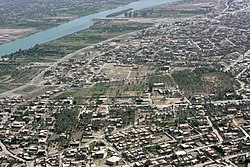Anbar (town)
Anbar
الأنبار | |
|---|---|
 | |
| Coordinates: 33°22.5′N 43°43′E / 33.3750°N 43.717°E[1] | |
| Country | Iraq |
| Governorate | Al Anbar |
Anbar (
Its ruins are near modern
History
Origins

The city is located on the left bank of the Middle
Sasanian period
The town was originally known as Misiche (
The city was fortified by a double wall, possibly through the use of Roman prisoner labour; it was
Islamic period
The city fell to the
The Arabs retained the name (Fīrūz Shābūr) for the surrounding district, but the town itself became known as Anbar (
According to medieval Arabic sources, most of the inhabitants of the town migrated north to found the city of Hdatta south of Mosul.[9] The famous governor al-Hajjaj ibn Yusuf cleared the canals of the city.[8]
It continued to be a place of much importance throughout the Abbasid period.
The town was sacked again in 1262 by the
Ecclesiastical history
Anbar used to host an
- Narses fl. 540
- Simeon fl. 553
- Salibazachi fl. 714
- Paul fl. 740
- Theodosius
- John fl. 885
- Enos 890
- Elias fl. 906-920
- Jaballaha fl. 960
- Sebarjesus
- Elias II fl. 987
- Unnamed bishop fl. 1021
- Mundar fl. 1028
- Maris fl. 1075
- Zacharias fl. 1111
Titular see
Anbar is listed by the Catholic Church as a titular see of the Chaldean Catholic Church,[14] established as titular bishopric in 1980.
It has had the following incumbents:
- Titular Archbishop Bassorah of the Chaldeans(Iraq) (1980.10.03 – 1981.11.10)
- Titular Bishop Apostolic Exarchin the United States of America (1982.01.11 – 1985.08.03)
- Titular Bishop Shlemon Warduni (since 2001.01.12), Curial Bishop of the Chaldean Catholic Church
Today
It is now entirely deserted, occupied only by mounds of ruins, whose great number indicate the city's former importance.[12] Its ruins are 5 kilometres (3.1 mi) northwest of Fallujah, with a circumference of some 6 kilometres (3.7 mi). The remains include traces of the late medieval wall, a square fortification, and the early Islamic mosque.[8]
Citations
- ^ a b c d e f g h i Streck & Duri 1960, p. 484.
- ^ Thomas A. Carlson et al., “Peruz Shapur — ܐܢܒܐܪ ” in The Syriac Gazetteer last modified December 9, 2016, http://syriaca.org/place/211.
- ^ a b c d e Brunner 1975, p. 759.
- ^ a b Frye 1983, p. 125.
- ^ a b c ODLA, "Peroz-Shapur" (J. Wienand), p. 1159.
- OCLC 923562173.
- ^ Le Strange 1905, pp. 65–66.
- ^ a b c d e f g h i j k l m Streck & Duri 1960, p. 485.
- ISBN 9789004081185. Retrieved 12 October 2012.
- ^ Le Strange 1905, p. 66.
- ^ Le Strange 1905, pp. 66–67.
- ^ a b Peters 1911.
- OCLC 955922747.
- ISBN 978-88-209-9070-1), p. 832
General sources
- Brunner, Christopher (1968–1991). "Geographical and administrative divisions: settlements and economy". The Cambridge History of Iran (8 vols.). Cambridge: Cambridge University Press. pp. 747–777.
- Frye, R. N. (1968–1991). "The political history of Iran under the Sasanians". The Cambridge History of Iran(8 vols.). Cambridge: Cambridge University Press. pp. 116–180.
- OCLC 1044046.
- Nicholson, Oliver, ed. (2018). ISBN 978-0-19-866277-8.
- This article incorporates text from a publication now in the public domain: Peters, John Punnett (1911). "Anbar". In Chisholm, Hugh (ed.). Encyclopædia Britannica. Vol. 1 (11th ed.). Cambridge University Press. p. 944.
- Streck, M. & Duri, A. A. (1960). "Al-Anbār". In OCLC 495469456.
- GCatholic, with titular incumbent biography links

